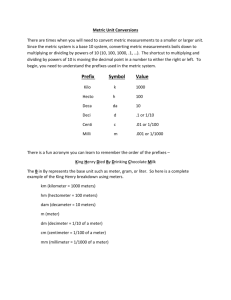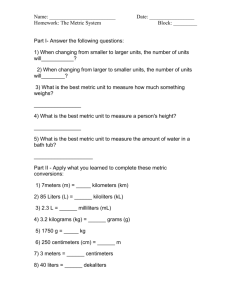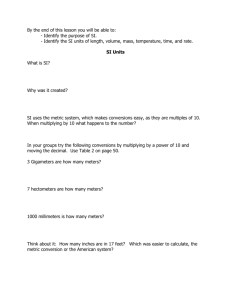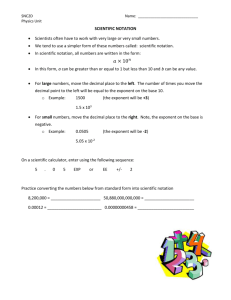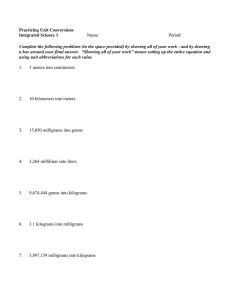9/20/12 1.2 Distance and Time
advertisement
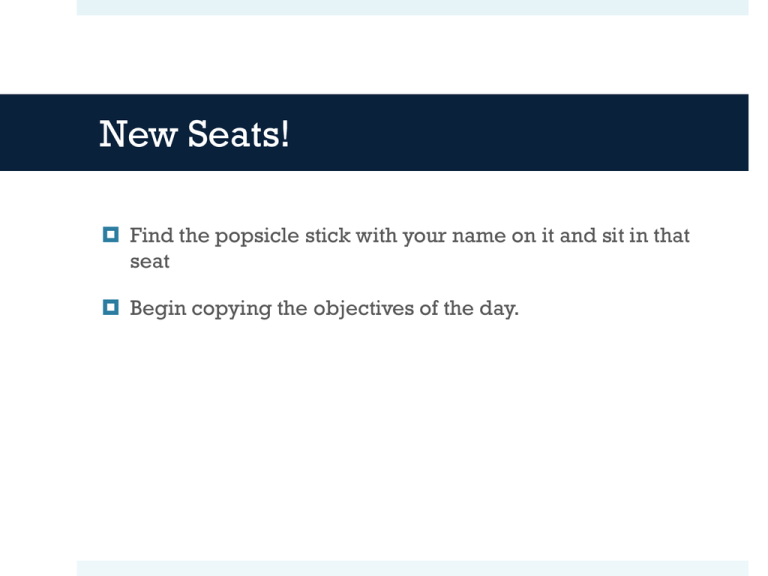
New Seats! Find the popsicle stick with your name on it and sit in that seat Begin copying the objectives of the day. Distance and Time 1.2 pp 11-16 Mr. Richter Agenda New Seats! Collect Posters (Rubrics attached!) Video Consent Forms Warm-Up Finish Yesterday’s Notes (if applicable) Any questions about the quiz? Introduction to the Metric System Notes Systems of Units (The Metric System) Metric Prefixes and Unit Conversion Distance and Length Time Distance and Time Graphs Objectives: We Will Be Able To… Know the meaning of metric prefixes Express distances using the appropriate metric units. Convert between different metric prefixes using decimals. Interpret distance and time graphs. Warm-Up: There are 5280 feet in a mile. There are 1000 meters in a kilometer. How many feet are in 4 miles? How many meters are in 4 kilometers? For Tomorrow’s Quiz You Should: Review your notes Review the slides online Pay special attention to things I have repeated (Like vocab, objectives, homework problems…) Bring a sharpened pencil and be ready to go at the bell tomorrow The Metric System The Metric System There are two common standardized systems of measurement. The English (British) system uses inches, feet, yards and miles. The International System (SI) or metric system uses centimeters, meters and kilometers. The vast majority of countries and scientists use the metric system. Why? It’s easier! The Metric System The metric system is based on powers of 10. Metric prefixes are used to indicate how large or how small a unit is. Or… how many powers of 10 larger or smaller than the unit is the measurement. For example: 23 kilometers is 1000 times larger than 23 meters. The prefix “kilo-” stands for 1000. You will be asked to memorize the list of prefixes to the right. The Metric System and Scientific Notation Scientists also use scientific notation, along with metric prefixes, to indicate very large or very small numbers. It looks like: 23000 meters = 2.3 x 104 meters, oooor… 0.0046 meters = 4.6 x 10-3 meters This is an introduction. We will see this later on in the year. Don’t freak out yet. Metric Prefix Practice Work by yourself in your notes to answer each question. Remember to think in terms of being realistic: are meters larger or smaller than the original unit? How many meters is: 1. 42 kilometers 2. 4.2 kilometers 3. 0.42 kilometers 4. 4200 centimeters 5. 420 centimeters 6. 42 centimeters 7. 4.2 centimeters Warm-Up Work by yourself in your notes to answer each question. How many meters is: 1. 42 kilometers 2. 4.2 kilometers Remember to think in terms of being realistic: are meters larger or smaller than the original unit? 3. 0.42 kilometers If you can, try to do this from memory; without the prefix charts. 7. 4.2 centimeters 4. 4200 centimeters 5. 420 centimeters 6. 42 centimeters Warm-Up Convert 589 cm to: meters kilometers millimeters (If this is a struggle for you, you must seek extra help ASAP) Agenda Warm-Up Review Quiz Set Up Portfolios Review HW Distance and Length Distance and Time Graphs Objectives: We Will Be Able To… Know the meaning of metric prefixes Express distances using the appropriate metric units. Convert between different metric prefixes using decimals. Interpret distance and time graphs. Distance and Length Distance and Length What is measurement? A measurement tells you how much of something. A measurement requires a quantity and a unit. For example: If you are asked how far you live from school, you don’t answer “four”. That makes no sense. You probably mean “four miles”. Quantity and unit. Distance and Length Distance is: the amount of space between two points. Sometimes we refer to distance as position, or the distance away from zero, the origin. Distance is measured in (SI) units of length. micrometers millimeters centimeters meters (base unit) kilometers etc. Distance and Length The graphic below gives an idea as to which units are appropriate for what size distance. Time For many experiments, time is either an important factor or the independent variable. There are two ways to think about time in physics. Absolute time: when precisely did something occur? September 14, 2011 at 10:14 am Relative time: how long did something take to happen? 42.3 seconds This is called a time interval. Most experiments are measured in time intervals, and data is collected from t = 0. Distance and Time Graphs This graph has three distinct sections of time. Sketch the graph in your notes, then… In complete sentences, describe what you think is happening in each section. Distance and Time Graphs In your groups, sketch the graph (no numbers, just labels) of the position vs. time of an elevator that: Starts in the lobby (ground floor) Goes up to the third floor Up further to the seventh floor And ends up on the second floor. If you need help or have questions, ask! Wrap-Up: Did we meet our objectives? Metric prefixes are used to express how much larger or smaller a quantity is relative to the unit value. Distances are measured using the metric units of length: centimeters, meters, kilometers etc. The metric system is used because it is easy to convert between units of different sizes. Distance and time graphs show the relative position of an object as time passes. Homework pp 24-25 Reviewing Concepts #14, 15, 20 p 25 #3-5 p 26 Solving Problems #7
